Herons captivate birdwatchers with their elegant forms and intriguing behaviors. These wading birds, often spotted in wetlands, showcase a variety of survival strategies that make observing bird behavior a thrilling pursuit. From precise hunting techniques to meticulous grooming, herons demonstrate remarkable adaptations to their watery habitats. Whether you’re a novice birder or seasoned enthusiast, understanding these patterns enhances your wildlife encounters.
For more on bird behavior examples, explore related observations in natural settings.
Hunting Techniques in Herons
Hunting stands out as one of the most dynamic aspects of bird behavior among herons. These predators exhibit patience and precision, often remaining motionless for extended periods before striking with lightning speed. Each species has evolved unique methods suited to its environment, allowing them to thrive in diverse wetlands.
Great blue herons, for instance, venture beyond typical watery realms. They frequently hunt voles in short-grass meadows near wetlands, positioning themselves along runways and waiting for subtle movements.
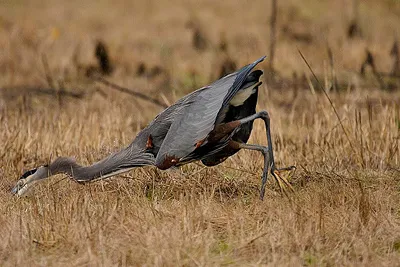 great blue heron catching a vole
great blue heron catching a vole
Once detected, they lunge forward, securing the rodent effortlessly. This adaptability highlights their opportunistic nature.
 great blue heron with vole
great blue heron with vole
In contrast, the American bittern excels in dense marshes. Its streaked plumage provides exceptional camouflage, mimicking swaying reeds in the breeze. This stealth allows it to ambush frogs or fish hidden in thick vegetation.
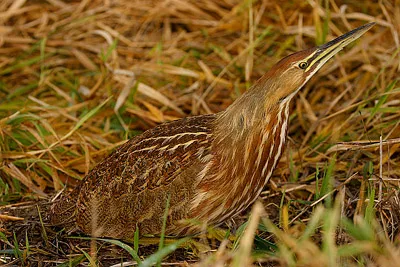 American bittern
American bittern
Green herons prefer perches on overhanging branches above water. From these vantage points, they stab at small fish and frogs with targeted strikes.
 green heron
green heron
Snowy egrets employ their vivid yellow feet to lure or flush out prey. The bright coloration draws curious fish closer, enabling a quick grasp.
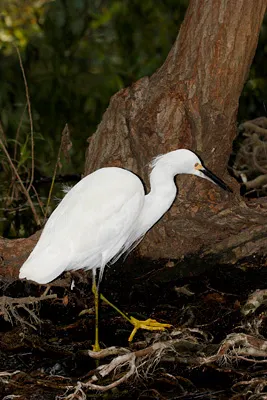 snowy egret
snowy egret
Reddish egrets take a more active approach, chasing fish through shallows with erratic runs that herd prey into vulnerable positions.
 reddish egret
reddish egret
These varied tactics underscore the diversity in heron hunting, influenced by habitat and anatomy.
Grooming for Survival
Post-hunt grooming is essential bird behavior for herons, maintaining feather integrity crucial for insulation and flight. Many species possess a specialized grooming claw on their middle toe, featuring a serrated edge that functions like a comb to disentangle plumage.
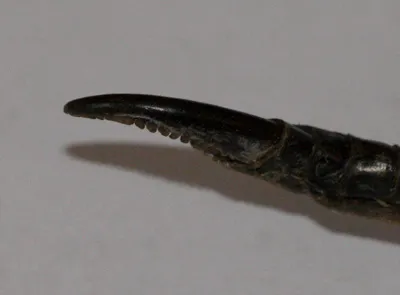 great blue heron grooming claw
great blue heron grooming claw
Additionally, herons produce “powder down” from feathers on their breasts and thighs. This fine powder absorbs slime from prey, which they distribute using their beak and claw before removing the residue.
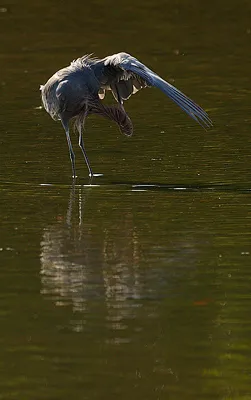 reddish egret preening
reddish egret preening
Regular preening prevents matting and bacterial growth, directly impacting their longevity in the wild. Observers often witness this ritual after feeding, emphasizing hygiene’s role in avian health.
Learn about bird nesting behavior to see how grooming integrates with reproductive cycles.
Social Interactions and Nesting
Herons display varied social behaviors depending on context. During foraging, great blue herons defend territories aggressively, chasing intruders to protect prime hunting spots. However, nesting shifts dynamics dramatically.
These birds form colonies known as heronries, where tolerance increases out of necessity. Both parents in many species share incubation and chick-rearing duties, fostering colony success despite close quarters.
Such interactions reveal a balance between competition and cooperation, vital for species persistence.
Thermoregulation Strategies
Herons employ clever thermoregulation to manage body heat without sweating or shivering. In hot conditions, they pant by fluttering their throat, akin to canine panting, while spreading wings to expose skin to cooling breezes.
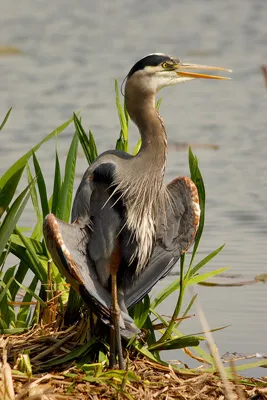 great blue heron thermoregulating
great blue heron thermoregulating
On chilly days, they fluff feathers to trap air for warmth or bask in sunlight. These behaviors, observable in varying climates, demonstrate physiological efficiency.
Resting and Roosting Habits
Daytime rest involves tucking their neck into a compact S-shape in sheltered areas. Surprisingly, many herons roost in trees overnight, elevating themselves above ground predators for safety.
This elevated sleeping posture protects them during vulnerable periods, blending rest with defense.
Dive deeper into great horned owl nesting behavior for comparisons with other predatory birds.
Conclusion: Why Observe Heron Behavior
Heron Behaviors—from hunting prowess to thermoregulation—offer endless fascination for bird enthusiasts. Visiting wetlands or refuges rewards patient observers with these natural spectacles. Always prioritize ethical viewing: maintain distance to avoid disturbance.
Equip yourself with binoculars and field guides for optimal experiences. Consult local wildlife experts for site-specific tips.
References
- All About Birds – Cornell Lab of Ornithology
- WhatBird – Heron Species Guide
- Sibley, David Allen. The Sibley Guide to Bird Life and Behavior.
- Stokes, Donald W. Stokes Guide to Bird Behavior (Vols. I-III).
